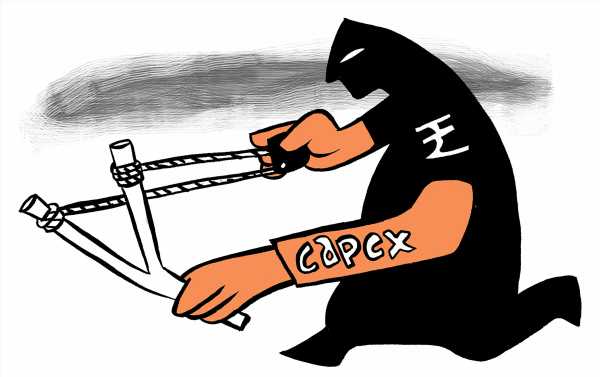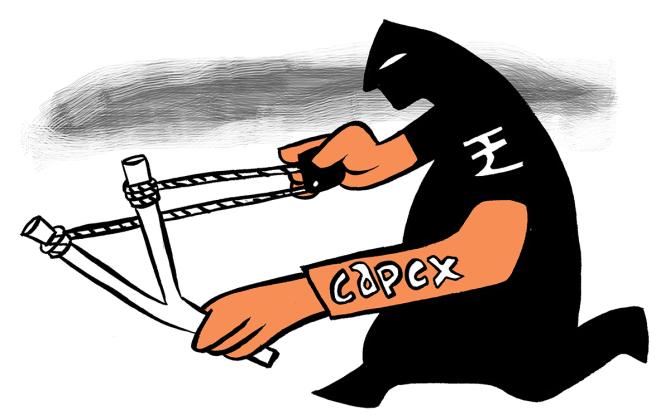India Inc capex growth enters slow lane in H1
The slowdown in corporate revenue growth over the last one year has begun to reflect in India Inc’s capital expenditure, or capex.
The country’s top listed companies are going slow on fresh investment in capacity expansion, in line with a deceleration in their top line growth.
The combined fixed assets of the listed companies, excluding banking, finance services and insurance (BFSI) and the government-owned oil & gas firms, were up 10.1 per cent year-on-year (Y-o-Y) during April-September 2023 (H1FY24) — the slowest in 18 months — as against 21.1 per cent Y-o-Y growth in H2FY23 (October 2022-March 2023) and 11.6 per cent growth in the April-September 2022 period (H1FY23).
In contrast, the combined net profit of these companies was up 12 per cent Y-o-Y in H1FY24 — the best in the last 18 months.
In comparison, the fixed assets of all the non-BFSI companies in the sample were up 10.4 per cent Y-o-Y in H1FY24, as against 19.1 per cent Y-o-Y increase in H2FY23 and 11.1 per cent growth in the year-ago period.
This tracks the slowdown in corporate revenue growth. The combined net sales of 725 companies, excluding BFSI and state-run oil & gas firms, were up just 4.2 per cent Y-o-Y in H1FY24 – the lowest half-yearly increase in the last three years and down sharply from 12.2 per cent growth in the second half of FY23 and 31.3 per cent growth in the first half of FY23.
The slowdown in net sales is even sharper if public sector oil & gas companies are included.
The analysis is based on a common sample of 725 companies from the BSE500, BSE MidCap and BSE SmallCap indices, excluding BFSI, stock broking and public sector oil & gas firms such as Indian Oil, Oil and Natural Gas Corporation, Bharat Petroleum (BPCL), Hindustan Petroleum (HPCL), and GAIL (India).
State-run oil & gas companies have been kept out of the study as their revenue and profit cycle is influenced by government policy on fuel prices.
The numbers have also been adjusted for the listed subsidiaries of listed holding and operating companies in the sample.
Experts say a deceleration in revenue growth is the key reason for the decline in India Inc’s fixed asset-to-turnover ratio, which is arrived at by dividing revenue by fixed assets.
The ratio indicates how efficient a company is at generating revenue from its fixed assets.
“A way of looking at capacity utilisation in the economy is through the lens of the ratio of turnover to fixed assets of India Inc, especially for the non-financial sector.
“The turnover-to-fixed assets ratio of companies witnessed moderation in H1FY24 compared to H1FY23.
“The main reason behind this is the softening of sales numbers, which is visible since the beginning of this financial year,” said Madan Sabnavis, chief economist at Bank of Baroda.
The turnover (or net sales or revenue) to asset ratio for 725 companies in the Business Standard sample declined to 0.437 in H1FY24 from 0.446 in H2FY23 and 0.442 in H1FY23.
This suggests a decline in capacity utilisation in the economy in the first half of FY24 compared to the last fiscal, which in turn has cut the financial incentive for companies to spend on capex and raise their production capacity.
Historically, there is a close correlation between growth in net sales and investment in fixed assets.
Similarly, the numbers suggest a positive correlation between the turnover-to-asset ratio and fixed asset growth.
Analysts attribute the slowdown to subdued consumer demand.
“Beyond automobile sales, there has been a sharp deceleration in consumer demand in the economy in FY24 due to poor growth in household income and rise in cost of living.
“This gives little incentive for companies to invest in capacity expansion,” said Dhananjay Sinha, co-head of equities and head of research of strategy and economics at Systematix Group.
According to Sinha, companies are now focussed on expanding their margin and profit through cost cutting rather than investing in growth.
The sectoral break-up of the reported half-yearly balance sheet suggests a slowdown in capex in all key capital-intensive sectors with the exception of oil & gas and power.
For example, the combined fixed assets of the automobile sector were up 6.8 per cent Y-o-Y in H1FY24, but the growth was lower than 9.2 per cent Y-o-Y in H2FY23.
Similarly, fixed asset growth in the mining & metals sector slowed down to 6.4 per cent Y-o-Y from 8.6 per cent Y-o-Y in H2FY23; in the cement sector, it declined to 4 per cent Y-o-Y from 8.2 per cent in H2FY23, and in telecom (including Reliance Industries), combined fixed assets were up 17.7 per cent in H1FY24, though down sharply from 61.7 per cent Y-o-Y growth in H2FY23.
In comparison, fixed assets of public sector oil & gas companies were up 11.9 per cent in H1FY24, an improvement from 8.3 per cent Y-o-Y growth in H2FY23, and power companies’ fixed assets were up 5.9 per cent in H1FY24 up, as against 5.8 per cent Y-o-Y growth in H2FY23.
Source: Read Full Article


